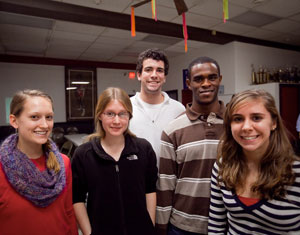Technology Clinic gives final recommendations to manage water runoff in the neighborhood
 Students in this year’s Technology Clinic gave their final presentation on their work with Easton’s West Ward Neighborhood Partnership on issues concerning the management of surface water runoff.
Students in this year’s Technology Clinic gave their final presentation on their work with Easton’s West Ward Neighborhood Partnership on issues concerning the management of surface water runoff.
Tech Clinic is a hands-on course founded in 1986 that brings together students from different majors to help solve real-world problems of a business, nonprofit organization, or government body. This project is a continuation of a previous Tech Clinic’s efforts in the West Ward to improve the neighborhood’s urban ecology, which concerns interactions between people and nature in city environments.
The project, titled Water in the West Ward, focused on possible ways to reduce and manage water runoff in a portion of the heavily-paved West Ward, the adjoining escarpment, and the Lehigh River.
The students used information from a previous study to pinpoint areas of low permeability on a map and noticed that although technically about half of the West Ward is permeable, that percentage could be inaccurate due to the physical landscape of the area. “Some of the areas that are considered more permeable actually have pretty steep elevations. The water would travel across it quickly and not have a chance to absorb,” says Hanna Pingry ’10 (Huntington, Pa.), a geology and art double major.
The groups’ suggestions to deal with flooding caused by impermeability include the use of rain gardens, detention ponds, community gardens, and rain barrels.Collection of water via these methods serves a dual purpose: slowing the flow of water and using the water as a resource.
Commonly included in homes built in the West Ward before the turn of the century, cisterns are another option for capturing and using rain water. Megan Feeney ’12 (Webster, N.Y.), an English major, says, “Between April and October, Easton receives about 30 inches of precipitation. If a homeowner collected one fourth of the volume of rain that ran over the surface of a relatively small roof, even if about 10 percent of the water evaporated, the homeowner would still be able to collect 8,500 gallons of water. This water could be used for a number of purposes, such as washing cars, watering gardens and lawns, and flushing toilets.”
The students, with the help of the West Ward Neighborhood Partnership, held two workshops during December to assist residents in identifying ways to save water and raise awareness about water issues in the area. Bradley Williams ’10 (Mariottsville, Md.), who has a self-designed major in multimedia design and marketing, says that from a green education standpoint, it is important to inform residents about water conservation. “It takes a considerable amount of energy to process water and distribute it, so conserving water equates to conserving energy,” he says.
Faculty adviser Lawrence Malinconico, associate professor of geology and environmental geosciences, hopes the study can help other areas with similar issues. “The idea is that we can use the West Ward as an example for others communities. Perhaps as they go through rehabilitation and renovation, it could serve as a model. A lot of flooding worldwide is exacerbated by urbanization, paving over its surfaces, and the West Ward is an excellent example of that,” he explains.
Other members of the team are Sam Bloom ’10 (Washington, D.C.), a double major in religious studies and government & law; and Cara Murphy ’11 (New Providence, N.J.), a psychology major. Dan Bauer, professor of anthropology and sociology, also serves as a faculty adviser.
 Students in this year’s Technology Clinic gave their final presentation on their work with Easton’s West Ward Neighborhood Partnership on issues concerning the management of surface water runoff.
Students in this year’s Technology Clinic gave their final presentation on their work with Easton’s West Ward Neighborhood Partnership on issues concerning the management of surface water runoff.